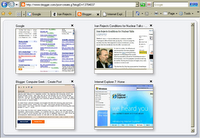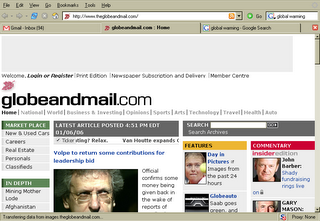Internet Explorer 7 review
Recently tried out the latest beta of Internet Explorer 7 and here are some of my thoughts on it.
First of, it's ugly. I thought IE6 was ugly but IE7 takes the cake. The screen you see when you start is one of these run-once screens, which in this case, asks you about local settings, probably for using MSN - I don't.

IE7 is a long overdue upgrade which has some new features that other browsers have had for sometime. Tabbed browsing is probably the most important one. Instead of opening each website in a separate window, the websites are contained within the single browser window. Tabs near the top of the browser let you switch between websites. Once you've used tabbed browsing, you'll never want to go back. To open a link in a new tab (thus keeping your existing website available), click the middle mouse button or scroll-wheel. See below for a crop of the tabs.
 One thing they've done with tabbed browsing that I'd like to see other browsers implement, particularly Firefox, is a preview ability. Have a lot of tabs and don't want to have to click through them one by one to remember what's in them? Click the Quick Tabs button to the left of the tabs themselves. See the screenshot on the left.
One thing they've done with tabbed browsing that I'd like to see other browsers implement, particularly Firefox, is a preview ability. Have a lot of tabs and don't want to have to click through them one by one to remember what's in them? Click the Quick Tabs button to the left of the tabs themselves. See the screenshot on the left.
Also added is some new security features, the most obvious of which is a phishing website check. Phishing is when scammers try to trick you into giving them your login information for other websites by pretending to be them. For example, you may an email that looks like it's from your bank asking you to login and confirm your information or your account will be frozen. If you click on their link and do so, you'll actually be visiting their website though it may appear legitimate. When you "login" there, you'll actually be giving them your login information which they'll use later to empty your bank account. This phishing check compares the websites you visit against an updated list of phishing websites. I'm not sure how effective this measure will be since phising websites are often taken down within 24 hours after authorities know of them. If Microsoft knows of it, chances are the site is no longer available anyway. It's not a bad idea, though.
Two other notable features are RSS Feeds & zooming. If you're a blogging or news junkie, chances are you already know about RSS. For the rest of you, RSS (Really Simple Syndication) is a protocol used to deliver text snippets or headlines from regularly updated websites (called a feed). This way, you can look at the feed to decide if the article is worth visiting the website to read entirely. Firefox and other browsers have also had this feature for a while but it's great to see available in IE, too. I'd like to see Live Bookmarks added to IE as well.
Zooming is a cool feature that I'd like to see Firefox adopt. Opera is the only other web browser I know to use it but it can be very handy. Rather than just sizing up the font, which every browser does, zooming actually is just like with other application. The page layout is retained but it's just blown up in size. Click on the magnifying glass in the lower-right corner once and the zoom level changes to 125%. Click it again and you're up to 150%. You can also click the arrow to the right of it and choose your level from 50 to 400%. Zooming is particularly useful on websites with small graphics that you need a better look at.
IE has finally added a search engine to the browser toolbar. Of course, the default is MSN, but you can add other engines, including Google. Glad to see this feature which has been in both Opera and Firefox for some time.
If you're using IE 6, IE 7 is definitely a better browser. The security enhancements alone are worth the upgrade. Even though it's in beta, it's very stable and Microsoft seems to be pushing it for everyone. If you're using an alternative web browser such as Firefox or Opera, there's not much here you haven't seen already. And Firefox is a lot more expandable with its extensions and has always been more secure. And Firefox is definitely more attractive!

IE 7 will be the version used in the upcoming Vista release of Windows.
First of, it's ugly. I thought IE6 was ugly but IE7 takes the cake. The screen you see when you start is one of these run-once screens, which in this case, asks you about local settings, probably for using MSN - I don't.

IE7 is a long overdue upgrade which has some new features that other browsers have had for sometime. Tabbed browsing is probably the most important one. Instead of opening each website in a separate window, the websites are contained within the single browser window. Tabs near the top of the browser let you switch between websites. Once you've used tabbed browsing, you'll never want to go back. To open a link in a new tab (thus keeping your existing website available), click the middle mouse button or scroll-wheel. See below for a crop of the tabs.
 One thing they've done with tabbed browsing that I'd like to see other browsers implement, particularly Firefox, is a preview ability. Have a lot of tabs and don't want to have to click through them one by one to remember what's in them? Click the Quick Tabs button to the left of the tabs themselves. See the screenshot on the left.
One thing they've done with tabbed browsing that I'd like to see other browsers implement, particularly Firefox, is a preview ability. Have a lot of tabs and don't want to have to click through them one by one to remember what's in them? Click the Quick Tabs button to the left of the tabs themselves. See the screenshot on the left.Also added is some new security features, the most obvious of which is a phishing website check. Phishing is when scammers try to trick you into giving them your login information for other websites by pretending to be them. For example, you may an email that looks like it's from your bank asking you to login and confirm your information or your account will be frozen. If you click on their link and do so, you'll actually be visiting their website though it may appear legitimate. When you "login" there, you'll actually be giving them your login information which they'll use later to empty your bank account. This phishing check compares the websites you visit against an updated list of phishing websites. I'm not sure how effective this measure will be since phising websites are often taken down within 24 hours after authorities know of them. If Microsoft knows of it, chances are the site is no longer available anyway. It's not a bad idea, though.
Two other notable features are RSS Feeds & zooming. If you're a blogging or news junkie, chances are you already know about RSS. For the rest of you, RSS (Really Simple Syndication) is a protocol used to deliver text snippets or headlines from regularly updated websites (called a feed). This way, you can look at the feed to decide if the article is worth visiting the website to read entirely. Firefox and other browsers have also had this feature for a while but it's great to see available in IE, too. I'd like to see Live Bookmarks added to IE as well.
Zooming is a cool feature that I'd like to see Firefox adopt. Opera is the only other web browser I know to use it but it can be very handy. Rather than just sizing up the font, which every browser does, zooming actually is just like with other application. The page layout is retained but it's just blown up in size. Click on the magnifying glass in the lower-right corner once and the zoom level changes to 125%. Click it again and you're up to 150%. You can also click the arrow to the right of it and choose your level from 50 to 400%. Zooming is particularly useful on websites with small graphics that you need a better look at.
IE has finally added a search engine to the browser toolbar. Of course, the default is MSN, but you can add other engines, including Google. Glad to see this feature which has been in both Opera and Firefox for some time.
If you're using IE 6, IE 7 is definitely a better browser. The security enhancements alone are worth the upgrade. Even though it's in beta, it's very stable and Microsoft seems to be pushing it for everyone. If you're using an alternative web browser such as Firefox or Opera, there's not much here you haven't seen already. And Firefox is a lot more expandable with its extensions and has always been more secure. And Firefox is definitely more attractive!

IE 7 will be the version used in the upcoming Vista release of Windows.

